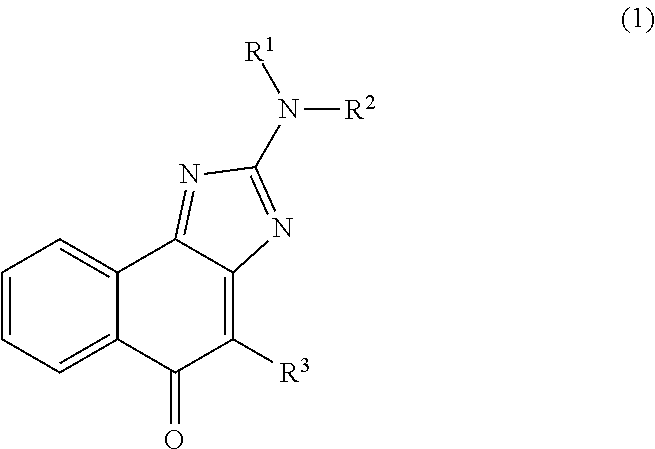2-substituted amino-naphth (1,2-d) imidazol-5-one compounds or pharmaceutically acceptable salts thereof
- Summary
- Abstract
- Description
- Claims
- Application Information
AI Technical Summary
Benefits of technology
Problems solved by technology
Method used
Image
Examples
reference example 1
4-Chloro-2-(dimethylamino)-5H-naphth[1,2-d]imidazol-5-one
[0129]
[0130]2,3-Dichloro-1,4-naphthoquinone (50 g), 1,1-dimethylguanidine sulfate salt (30 g), and potassium carbonate (46 g) were dissolved in acetonitrile (500 mL) and then the reaction mixture was heated at reflux for 4 hours. The reaction solution was cooled to room temperature, and then chloroform was added thereto and the reaction solution was filtered. The resulting filtrate was concentrated under reduced pressure, and then chloroform and water were added to the residue and the target substance was extracted into the organic layer. The resulting organic layer was washed with saturated brine and then dried over anhydrous sodium sulfate. The organic layer was then concentrated under reduced pressure. Ethyl acetate was added to the residue and the target substance was recrystallized to yield Reference example 1 (32 g). 1H-NMR (CDCl3) δ: 8.12 (1H, dd, J=7.3, 1.8 Hz), 8.05 (1H, dd, J=7.6, 1.6 Hz), 7.64-7.55 (2H, m), 3.60 (3H...
reference examples 2 to 6
[0131]According to a similar method to Reference example 1, compounds of Reference examples 2 to 6 shown in the following table were obtained using corresponding raw materials.
TABLE 2ReferenceexampleRNMR, LCMS21H-NMR (CDCl3) δ: 8.13-8.10 (1H, m), 8.06-8.04 (1H, m), 7.63-7.54 (2H, m), 3.99 (2H, q, J = 7.3 Hz), 3.91 (2H, q, J = 7.3 Hz), 1.40 (3H, t, J = 7.3 Hz), 1.37 (3H, t, J = 7.3 Hz). R.T. 1.04 min, m / z 288 (M + 1).31H-NMR (CDCl3) δ: 8.13-8.10 (1H, m), 8.05-8.03 (1H, m), 7.63-7.54 (2H, m), 4.10-4.07 (2H, m), 3.96-3.94 (2H, m), 2.14-2.06 (4H, m). R.T. 0.86 min, m / z 286(M + 1)41H-NMR (CDCl3) δ: 8.13 (1H, dd, J = 7.3, 1.8 Hz), 8.03 (1H, dd, J = 7.3, 1.4 Hz), 7.65-7.57 (2H, m), 4.22 (2H, t, J = 4.8 Hz), 4.11 (2H, t, J = 4.8 Hz), 3.891-3.87 (4H, m). R.T. 0.84 min, m / z 302 (M + 1).51H-NMR (CDCl3) δ: 8.12 (1H, dd, J = 7.8, 1.4 Hz), 8.03 (1H, dd, J = 7.3, 1.8 Hz), 7.64-7.56 (2H, m), 4.23 (2H, t, J = 5.0 Hz), 4.12 (2H, t, J = 5.0 Hz), 2.63-2.59 (4H, m), 2.38 (3H, s). R.T. 0.51 min, m / z 315 ...
example 1
2-(Dimethylamino)-4-(4-methoxyphenyl)-5H-naphth[1,2-d]imidazol-5-one
[0133]
[0134]4-Chloro-2-(dimethylamino)-5H-naphth[1,2-d]imidazol-5-one (2.0 g), 4-methoxyphenylboronic acid (1.7 g), potassium carbonate (3.1 g), and tetrakis(triphenylphosphine)palladium (0) (444 mg) were added to a mixed solution of 1,2-dimethoxyethane (200 mL) and water (40 mL), and the reaction mixture was heated at reflux for 3 hours. The reaction solution was cooled to room temperature and then filtered through Celite. The resulting filtrate was then concentrated under reduced pressure. Chloroform and water were added to the resulting residue, and then the target substance was extracted into the organic layer. The resulting organic layer was washed with saturated brine, and then dried over anhydrous sodium sulfate and concentrated under reduced pressure. The residue was purified by silica gel column chromatography and the resulting solid was washed with methanol to yield the compound of Example 1 (2.1 g). 1H-NM...
PUM
 Login to View More
Login to View More Abstract
Description
Claims
Application Information
 Login to View More
Login to View More - R&D
- Intellectual Property
- Life Sciences
- Materials
- Tech Scout
- Unparalleled Data Quality
- Higher Quality Content
- 60% Fewer Hallucinations
Browse by: Latest US Patents, China's latest patents, Technical Efficacy Thesaurus, Application Domain, Technology Topic, Popular Technical Reports.
© 2025 PatSnap. All rights reserved.Legal|Privacy policy|Modern Slavery Act Transparency Statement|Sitemap|About US| Contact US: help@patsnap.com



